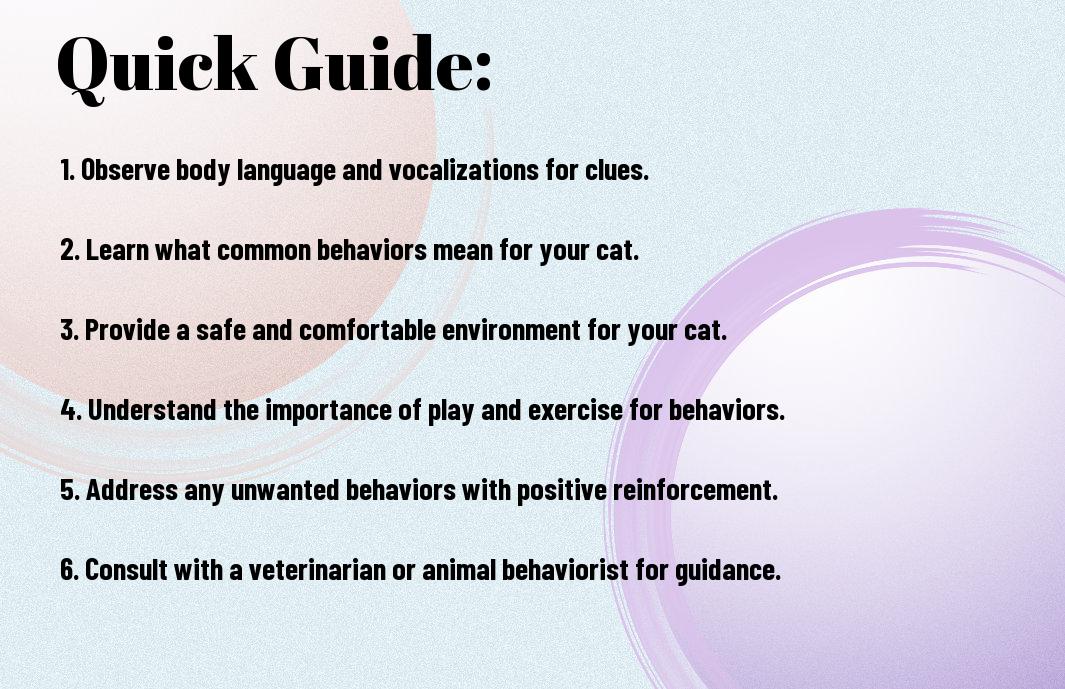There’s no denying that cats have a unique way of communicating with us, often leaving us puzzled by their behaviors. To truly understand your feline companion, it’s important to decode their body language, vocalizations, and habits. In this comprehensive guide, we will explore the ins and outs of feline behavior to help you build a stronger bond with your mysterious housemate.

Deciphering Feline Communication
Vocalizations and What They Mean
Meaningful communication through vocalizations is an important aspect of understanding your cat’s behavior. From purring to meowing, each sound conveys a different emotion or need. Purring often signifies contentment, while a loud, persistent meow may indicate hunger or a desire for attention. Growling or hissing are signs of fear or aggression and should be approached with caution.
Body Language and Its Interpretations
For every vocal cue, there are multiple layers of communication within a cat’s body language. The position of their ears, tail, and whiskers can provide valuable insights into their mood and intentions. A cat with flattened ears and a swishing tail may be feeling agitated or anxious, while a relaxed cat with slightly twitching ears signals they are in a playful mood.
What may seem like random behaviors to an untrained eye are actually purposeful actions that cats use to communicate with their owners and other animals. By closely observing your cat’s body language and vocalizations, you can better understand their needs and strengthen the bond between you.
Exploring the Types of Cat Behavior
Little is known about feline behavior, but understanding your furry friend’s actions can help you build a stronger bond with them. Cats exhibit a variety of behaviors that can range from playful and affectionate to aloof and aggressive. Exploring these behaviors can provide valuable insights into your cat’s emotions and needs.
- Playful behavior: Cats engage in play to exercise their hunting instincts and stay mentally stimulated.
- Aggressive behavior: Cats may display aggression due to fear, territoriality, or pain.
- Relaxed behavior: When a cat is lying on its back with its belly exposed, it signifies trust and relaxation.
- Marking behavior: Cats use scent glands to mark their territory by rubbing their face or spraying urine.
- Meowing behavior: Cats communicate with humans through different meow sounds to express their needs and emotions.
Common Behaviors and Their Causes
Assuming your cat’s playful behavior is normal can help you provide adequate mental stimulation and hunting opportunities. Lack of play can lead to boredom and destructive behavior. Cats may exhibit aggressive behavior when they feel threatened or stressed. It is crucial to address the underlying cause to help your cat feel safe and secure.
Unusual Behaviors and When to Be Concerned
Any sudden and drastic changes in your cat’s behavior, such as excessive hiding, aggression, or lethargy, may indicate an underlying health issue or emotional distress. It is crucial to observe these unusual behaviors and consult a veterinarian if necessary for further evaluation.
Recognizing the signs of unusual behavior and knowing when to seek professional help can ensure the well-being of your cat. Cats are masters at masking pain and discomfort, so attentive observation is key to identifying any potential concerns early on.
Causes
Understanding the underlying causes of your cat’s behavior is crucial in providing appropriate care and support. Various factors, such as environmental changes, health issues, or past experiences, can influence your cat’s behavior. Consulting with a veterinarian or a certified animal behaviorist can help address these causes and improve your cat’s overall well-being.

Factors Influencing Your Cat’s Behavior
Many factors can influence your cat’s behavior, from their environment to their health. Understanding these influences can help you better comprehend why your cat acts the way they do. Recognizing these factors can assist you in addressing any issues that may arise.
Environmental Influences and Their Impact
Environmental factors play a significant role in shaping your cat’s behavior. Things like the layout of your home, the presence of other animals, access to resources like food and water, and the availability of hiding spots or perches can all impact how your cat behaves. Cats are very sensitive to changes in their environment, so even small adjustments can affect their mood and actions.
Health-Related Behaviors and Indicators
Any underlying health issues can also greatly influence your cat’s behavior. Cats are masters at hiding signs of illness, so it’s crucial to pay attention to any changes in their behavior. Things like excessive grooming, changes in appetite, litter box issues, or sudden aggression can all be indicators that something is wrong. Regular vet check-ups and monitoring your cat’s behavior can help catch any health issues early on.
Understanding the various factors that can influence your cat’s behavior is necessary for providing them with the best possible care and ensuring their overall well-being.
Step-By-Step Guide to Bonding With Your Cat
To truly understand your cat’s behavior, it is crucial to build a strong bond with your feline friend. By establishing trust and a strong connection, you can gain insights into your cat’s emotions and preferences. Here is a step-by-step guide to help you create a lasting bond with your cat.
| Tips for Earning Your Cat’s Trust | Routine Activities to Strengthen Your Bond |
| 1. Approach your cat calmly and give them space to approach you on their terms. | 1. Establish a daily routine for feeding, playtime, and grooming. |
| 2. Use positive reinforcement such as treats and gentle petting to reward good behavior. | 2. Engage in interactive play sessions to keep your cat mentally stimulated and physically active. |
| 3. Respect your cat’s boundaries and signals when they need alone time. | 3. Create cozy and safe spaces for your cat to retreat to when they need privacy. |
Tips for Earning Your Cat’s Trust
Even though cats may seem independent, they value trust and security in their relationships. To earn your cat’s trust, it is crucial to approach them in a non-threatening manner and respect their boundaries. Use positive reinforcement to reward good behavior and build a strong foundation of trust.
- Assume that building trust with your cat takes time and patience.
Routine Activities to Strengthen Your Bond
On top of building trust, engaging in routine activities can further strengthen the bond between you and your cat. Establishing a consistent daily routine for feeding, playtime, and grooming can create a sense of security and predictability for your cat, reinforcing your connection.
Strengthening your bond through regular activities not only enhances your relationship with your cat but also improves their overall well-being and happiness. Consistency and quality time spent together will deepen your connection and understanding of your feline companion.

Correcting Unwanted Behaviors
After understanding your cat’s behavior, it’s important to address any unwanted behaviors that may arise. This chapter will guide you on how to correct these behaviors effectively.
Identifying and Understanding Problematic Behaviors
Unwanted behaviors in cats can range from scratching furniture to aggression towards humans or other pets. It’s crucial to identify the root cause of these behaviors before attempting to correct them. Understanding why your cat is behaving a certain way will help you address the problem more effectively.
Gentle and Effective Discipline Techniques
Problematic behaviors should be corrected using gentle and positive reinforcement techniques. Punishment or harsh discipline can cause fear and anxiety in cats, leading to more behavioral issues. Instead, focus on redirecting your cat’s behavior towards more appropriate activities through rewards, such as treats or toys.
It’s important to be consistent and patient when implementing discipline techniques. Cats respond well to positive reinforcement, so be sure to praise and reward good behavior to encourage more of it. Bear in mind, correcting unwanted behaviors takes time and effort, but with the right approach, you can help your cat become a well-behaved companion.
Pros and Cons of Various Training Methods
| Reward-Based Training | Aversive Training |
|---|---|
| Pros: Encourages positive behavior, strengthens bond with your cat | Pros: Can address specific behavior issues effectively |
| Cons: May take longer to see results, requires consistency | Cons: Can cause stress or fear in the cat, may damage the bond between you and your cat |
Reward-Based Training vs. Aversive Training
Even though both reward-based and aversive training methods can be used to modify your cat’s behavior, it’s important to consider the potential impact on your cat. Reward-based training focuses on positive reinforcement, which can be more effective in the long run and strengthens your relationship with your feline companion. On the other hand, aversive training, while it may show quicker results in some cases, can lead to stress, fear, and potential damage to the bond you share with your cat.
Understanding and Choosing the Right Method for Your Cat
Training your cat requires a deep understanding of their behavior and preferences. It is crucial to choose a method that aligns with your cat’s personality and your goals for training. Reward-based training is generally recommended as it creates a positive learning experience for your cat, leading to long-lasting results and a stronger bond between you and your pet.
To wrap up
Summing up, understanding your cat’s behavior is crucial for building a strong and fulfilling bond with your feline friend. By paying attention to their body language, vocalizations, and habits, you can decipher their needs and emotions more effectively. Remember to approach each cat as an individual with unique traits and preferences, and be patient in your efforts to communicate and connect with them.
With the knowledge gained from this ultimate guide, you are now equipped to navigate the complexities of your cat’s behavior with confidence. By taking the time to observe, learn, and respond appropriately, you can cultivate a deeper understanding and appreciation for your beloved pet. Ultimately, the effort you invest in decoding your cat’s behavior will lead to a stronger and more harmonious relationship between you and your furry companion.
FAQ
Q: What are common reasons for a cat’s aggressive behavior?
A: Cats can exhibit aggressive behavior due to fear, stress, pain, territorial issues, or improper socialization. It’s important to identify the root cause to address the behavior effectively.
Q: How can I interpret my cat’s body language?
A: Understanding your cat’s body language is crucial in deciphering their behavior. For example, a tail held high indicates confidence and happiness, while a twitching tail may signal agitation or excitement.
Q: Why do cats groom themselves excessively?
A: Excessive grooming in cats can be a sign of stress, skin irritation, or underlying medical issues. It’s imperative to monitor this behavior and consult a veterinarian if necessary.
Q: How can I help my cat feel more comfortable in stressful situations?
A: Providing a safe space, interactive toys, vertical perches, and engaging in regular playtime can help reduce stress and anxiety in cats. Consistency and creating a routine are key in helping your cat feel secure.
Q: What should I do if my cat displays sudden changes in behavior?
A: Sudden changes in a cat’s behavior could be a red flag for underlying health issues or environmental stressors. It’s best to observe their behavior closely, consult a veterinarian, and make necessary adjustments to ensure your cat’s well-being.

















